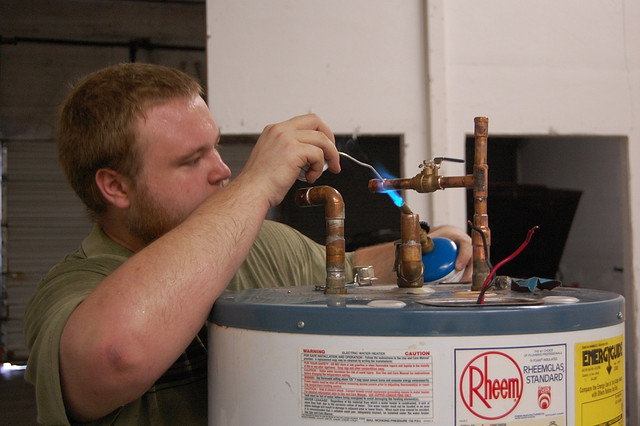You may take your home’s water heater for granted, but this is an important element of home comfort. Every time you enjoy fresh hot water for a shower, washing dishes or cleaning your clothing, your water heater is hard at work. Proper water heater maintenance will ensure that you always have clean hot water when you need it while operating our system at the lowest possible expense.
Add Insulation
Insulating your water heater is a simple maintenance task that you only need to do once to enjoy outstanding benefits. Insulation will reduce heat loss by as much as 45 percent while reducing your expenses by around 9 percent. Wrap the hot and cold water pipes in 3/8-inch foam. Secure the foam with 1-inch-thick fiberglass pipe wrap anywhere the insulating is less than six inches from the flue. Insulate the heater itself with an insulation blanket secured with foil tape.
Check the Anode Rod
The anode rod is the small slim rod hanging from the top of the water heater into the tank. The rod is made from magnesium or aluminum, which can corrode over time. You should examine the rod every three years.
Checking the state of the rod is easy. Simply unscrew it and pull the rod out partway to examine the condition. If it has corroded to a thickness of less than half an inch, you can see more than six inches of the steel wire at the core, or it’s coated with calcium, it’s time to get a new rod.
Adjust the Temperature
If you’re looking for a quick way to shave your energy expenses, just turn down the temperature on the water heater. For every 10 degrees you lower the water heater temperature, you can save up to 5 percent on your utility bills. The ideal temperature is 120 degrees.
Revisit this water heater maintenance task seasonally and any time you’re going to be out of town for three days or more. You may find that you can tolerate lower temperatures during warm seasons, minimizing summer energy expenses. Turning down the thermostat on your water heater while you’re away will save you the expenses of maintaining hot water no one will use.
Clean Up the Heater Space
You should have at least two feet of clearance around your water heater unless otherwise specified by the manufacturer. If you’re using your water heater closet for other types of storage, it’s time to reorganize and revisit this space. Move items so they’re at least two feet away from the unit.
Drain Sediment From the Tank
Sediment and debris build up in the tank over time. Draining water from the tank to clear out sediment is a water heater maintenance task you should take care of several times a year. Drain water from the heater until it runs clear. This is something you may want to turn to a professional for. Cleaning out the water will help your unit run more quietly and efficiently.
Check the Temperature Pressure Relief Valve
This is another bit of water heater maintenance that a professional can take care of during an annual checkup. Your technician will discharge the valve two or three times with an eye on its performance. He will also check for leaks and alert you to any necessary repairs before they seriously damage the performance of the unit.
Inspect the Area for Leaks and Drips
Your water heater is probably tucked away where you rarely see it. Pay your water heater a visit twice a year and examine the area for any signs of trouble. Water stains or standing water can indicate a problematic leak. If you notice these, make an appointment with your service technician.
A well-maintained water heater will help you maintain home comfort year round. Schedule regular water heater maintenance once a year to keep your system in good shape. Get set up with Griffith Energy Services, Inc. as a regular energy customer or call 888-474-3391 to keep your system in top condition.
Image via Flickr by sparr0




